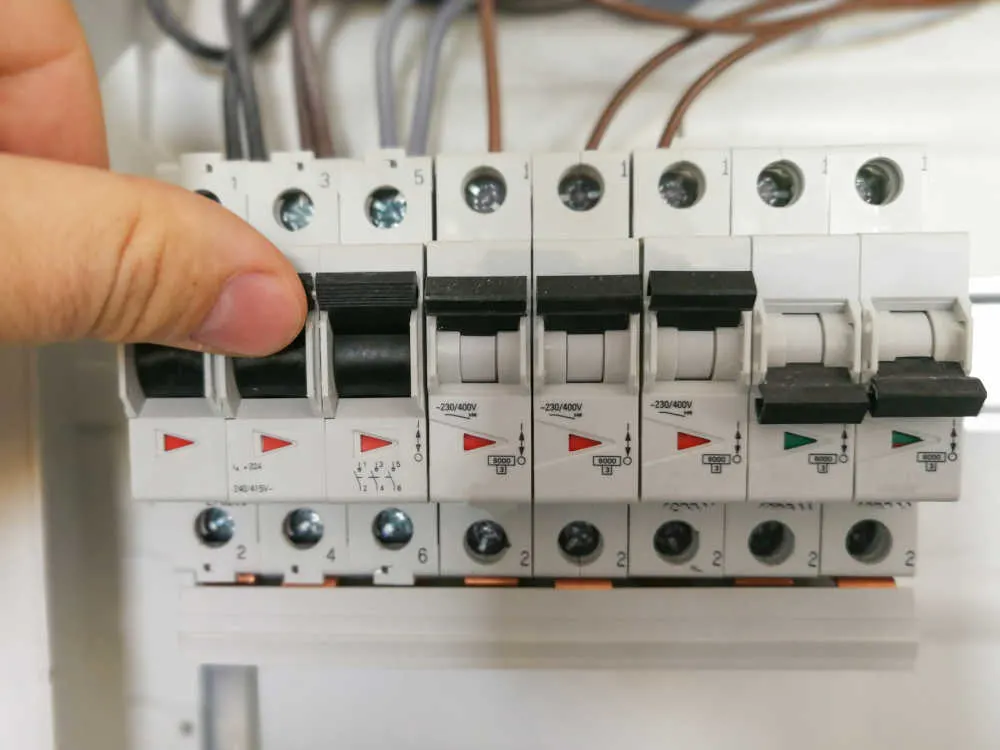Bath fans help to keep fresh air circulating in the bathroom and to remove excess moisture and dampness from the room. So, if a bath fan fuse blows, it will prevent the fan from running and over time you could be facing some serious problems. Additionally, the fact that the fuse has blown can indicate a dangerous underlying electrical issue that needs to be resolved urgently. Let’s go over the 4 most commonly experienced reasons for blown bath fan fuses and how to solve these problems.

The most common reason why bathroom fans trip breakers is that there is a short circuit in the electrical system. A GFCI could also be defective and could cut the power.
1. Short Circuiting Can Make Bath Fan Fuses Blow
One of the main reasons why bath fans blow fuses is due to a short circuit within the wiring system of the fan.
A short circuit can be caused by damaged or loose circuit wiring or even by the wiring in the fan itself. If the fan has a faulty or loose wire, it may cause the entire circuit to short.

Another possible cause for a bath fan short circuit is a fault in another device or appliance on the same circuit as the fan. For this to occur, the device or appliance would have to be running simultaneously with the fan. If this is the source of the short circuit, the fault may be mistakingly attributed to the fan, while the source is actually elsewhere.
This usually occurs with other devices in the bathroom or adjacent bedroom, but it the fault could exist in a completely different part of the house, depending on how the circuit has been designed.
To better understand the problem, let us take a closer look at some of the more common faults of this type and how to address these issues.
Ground Fault
A ground fault is a specific type of short circuit that can occur with a bath fan, and it is a very commonly experienced problem with this type of appliance.
A ground fault is usually caused by faulty or damaged wiring that allows the electrical current within the circuit to take an unexpected path to ground/earth.
This type of short circuit often occurs in old appliances, particularly if loose or damaged wiring comes into contact with conductive materials such as metal casings.
Ground faults are particularly dangerous in the bathroom, as they are likely to result in an electrical shock, which is particularly hazardous in a room that experiences a lot of moisture like the bathroom.
Arc Faults
Another type of short circuit is an arc fault. This is an extremely dangerous fault as it may go unnoticed and has the potential to cause fires and electrical surges in other parts of the house wiring.
Arc faults occur when a surge of electricity arcs between two conductive materials. This could be two wires touching where they should not, or it could be an exposed wire arcing electricity to a nearby metallic object.
Faulty or damaged wiring and exposed electrical terminals are usually the source of this type of short circuit.
Solution to Short Circuiting, Ground Faults, and Arc Faults
The solutions for short circuits, ground faults, and arc faults can be complicated due to the multiple possible causes of these electrical faults.
To check for damage and identify where the short circuit may be originating, the first step should be to check if there are any obvious issues such as spilled liquid or dampness in the ceiling.
If there are no obvious problems, then go through the appliances in the room to see which one is causing the issue. Turn everything off, and then turn on each appliance or device in the room systematically. If turning on the fan or another appliance or device causes the fault, then you have identified the source of the issue.
If there is any clear damage to a device, appliance, or wiring, or if you are unable to identify the cause of the short circuit, it is important to contact an electrician to resolve the issue.
Once the fault has been identified, whether it is the fan or light wiring, or wiring within the circuit, it is first important to leave the appliance turned off until the problem can be attended to. The faulty appliance or section of wiring will need to be replaced or safely repaired, depending on the fault, and this should only be done by a qualified electrician.
Prevent Blown Fuses Before They Occur
Preventing potential harm to people and possessions caused by short circuits, ground faults, and arc faults is as simple as installing the correct prevention measures in the circuit.
Ground Fault Circuit Interrupters (GFCI) and Arc Fault Circuit Interrupters (AFCI) should be installed on all appliances such as bath fans to prevent both electrical shocks, especially for appliances in the bathroom, and fire hazards, especially for appliances installed within walls or ceilings.
Such prevention measures can be life-saving and are of utmost importance with such appliances as bathroom fans. This article is an excellent resource to help understand why bath fans require such prevention measures.
2. Fuses Can Blow if the Bath Fan Has a Defective Motor
Another reason why bath fans blow fuses is a defective motor. A defective bath fan motor may overheat, which may cause a fuse to blow, or it may become jammed, which will cause the same problem.
If the bearings within the fan’s hub are old or rusted, the motor may be hindered enough to overheat, or become jammed, which will cause the fan to malfunction, which may blow a fuse.

Fan motors draw a lot of electrical current, and if the insulation in the motor is damaged because of wear and tear, age, or a build-up of dirt and grime, it is likely to cause a fault which will result in a blown fuse.
These problems are commonly experienced by old or unmaintained bath fan motors.
Solution to Defective Motors
If the blown fuse is caused by a defective fan motor, the repair options are usually quite simple.
If the fan has a build-up of grime, clean the fan thoroughly to prevent causing a blown fuse.
If the fan is jammed or overheating due to damaged or rusted bearings, replace the hub or replace/clean the bearing within the hub to resolve the issue.
Ultimately, if the problems reoccur, the only solution may be to replace the fan motor entirely. Once the motor is replaced and properly installed, it is unlikely to cause a blown fuse unless the source of the problem is elsewhere in the system.
If you hear your fan buzzing or humming, it could indicate that you have an electrical problem that needs to be addressed before it reaches the stage of causing a fuse to blow.
3. Overloaded Circuits Can Cause Fuses to Blow
A possible cause for a blown bath fan fuse is an overloaded circuit.
Overloading of an electrical circuit occurs when the current experienced by the circuit exceeds the rating of the protective devices within the circuit.

This does not always mean that there are a large number of devices or appliances running on the same circuit; if the circuit capacity is low, then even two or three devices or appliances may be more than it can handle safely.
Solution to Overloaded Circuits
To avoid overloading the circuit that the bath fan is running on, it is important to remove devices or appliances from the circuit.
This can be done by moving some appliances or devices to a different circuit or by unplugging devices that are running on the same circuit and only plugging them in when they are in use—ideally, when the bathroom fan is off.
Unplugging devices may be the only option in some cases, but this is often the safest option for preventing overloading the circuit and will help to save on electricity costs as well.
4. Installing the Wrong Fuse Can Cause It to Blow
A very common cause of a blown bath fan fuse is installing the incorrect fuse for the appliance or circuit.
Fuses are rated for specific amperage levels, and if a fuse is installed that has an amperage rating that is too low, it will quickly become overloaded when installed into the circuit, causing the fuse to blow.
This is often the case if a fuse is blowing repeatedly or if the same fuse in a circuit frequently blows.
Solution to Incorrect Fuses
The solution for a blown fuse due to the incorrect fuse being installed is simply to install the right fuse with the right amperage rating for the appliances and circuit that it will be used for.
If a fuse is installed that has a lower average rating than required, the fuse will simply blow as soon as the circuit is activated, which will protect the circuit and all of the appliances and devices running on it.
Installing a fuse that is rated too high for the circuit or appliances can be incredibly dangerous. In this case, the fuse will remain intact if there is a fault or a power surge, allowing the problem to continue, which will lead to an even more serious issue such as fire or severe electrical shocks.
It is vital to ensure that the correct fuse is installed for your bath fan to ensure the safety of the appliance and those in the near vicinity.
Sources
https://www.thespruce.com/addressing-ground-faults-4118975
